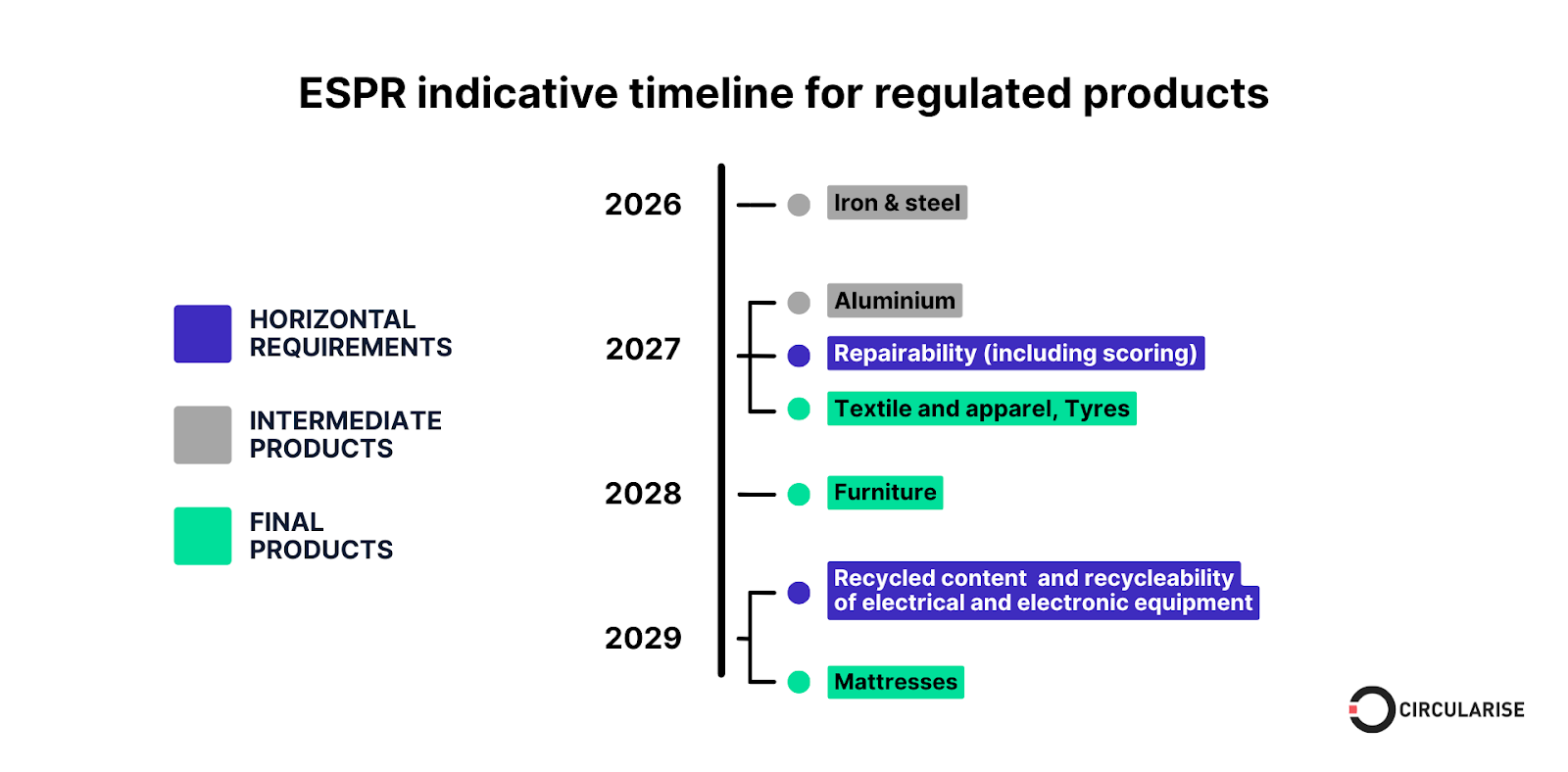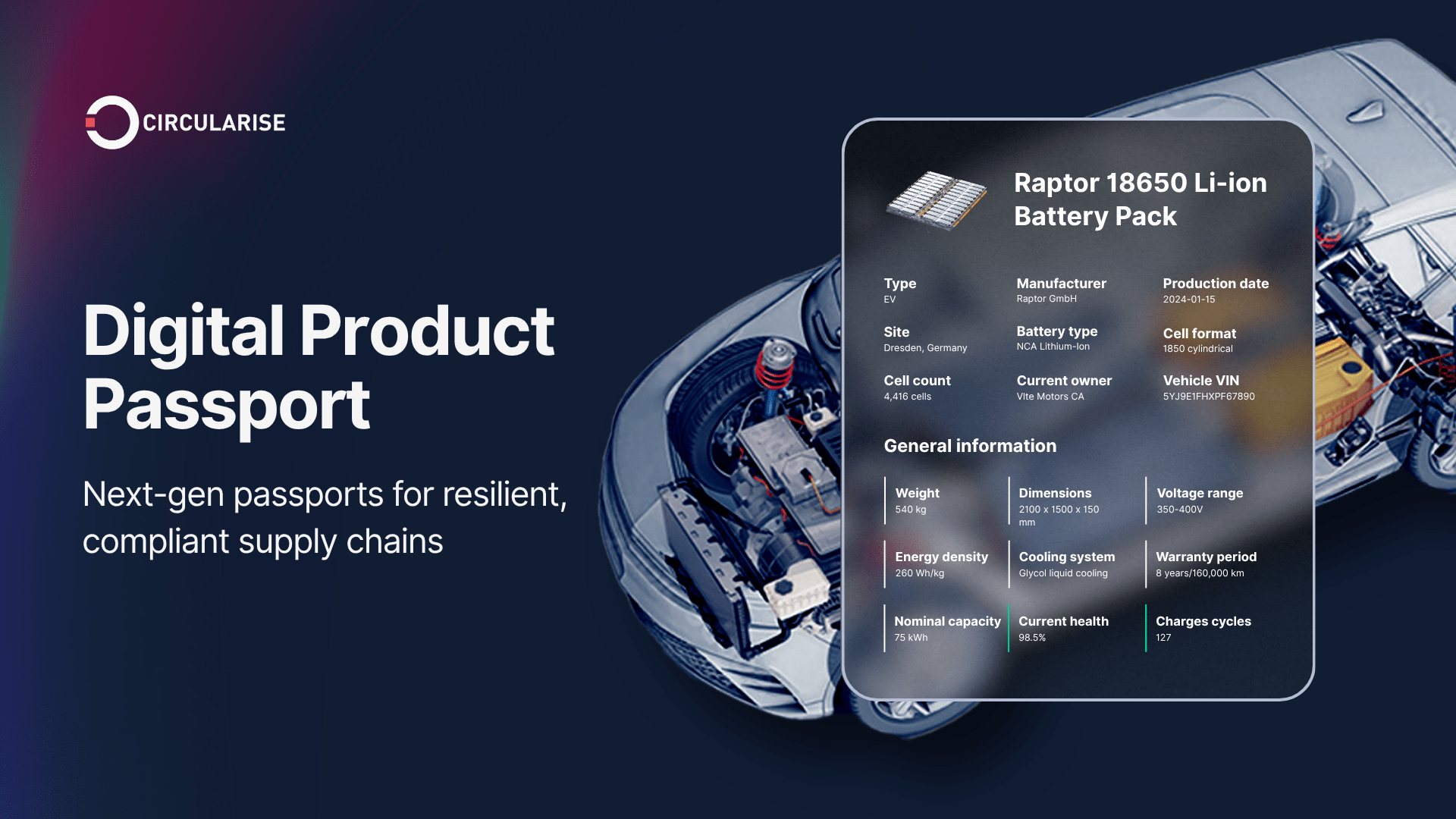The Ecodesign for Sustainable Products Regulation (ESPR) is a part of the package of rules following the 2020 Circular Economy Action Plan, comprising the European Green Deal. It came into effect on 18 July 2024. The EU Regulation on Sustainable Products replaces the previous Ecodesign Directive 2009/125/EC. Focusing on products which may have a significant impact on the environment, the EU ESPR is set to contribute to doubling the circularity rate of materials used in the EU.
Aimed towards an environmentally sustainable and circular economy, the ESPR is a significant milestone in the EU sustainable production initiative. Improving the circularity and energy efficiency of products circulating in the EU market represents a step towards promoting sustainable business models and practices on all levels, as well as a competitive and resilient market.
As this article provides updates, it’s important to highlight that the ESPR is part of a broader policy push under the 2025–2027 Working Plan, which also includes the newly announced Circular Economy Act and Clean Industrial Deal. These initiatives collectively aim to drive a more circular EU economy by setting product requirements and developing lead markets for sustainable, circular products. We will continue to update this article as new information becomes available.

Under the ESPR, a sustainable product must be characterised as:
- Using less energy
- Longer usage period
- Easily repairable
- Containing parts which may be disassembled and put to further use
- No or fewer substances of concern
- Easily recyclable and/or containing more recycled content
- Lower carbon and environmental footprint over its lifecycle
- Having improved availability of information on its sustainability
What is the timeline for ESPR implementation?
The Ecodesign for Sustainable Products Regulation was proposed in March 2022 as part of the EU Circular Economy Action Plan. In December 2023, the European Parliament and the European Council agreed on a provisional agreement of the Regulation. Adopted by the EU Parliament and EU Council in 2024, ESPR officially entered into force on 18 July 2024. It contains three main changes from the previous Ecodesign Directive, namely rules on Digital Product Passports (DPPs), green public procurement and destruction of unsold products.
With a clear roadmap for regulatory measures targeting key product groups and sustainability aspects, the ESPR will be regularly updated and made publicly available by the European Commission on a maximum three-year basis. Therefore, businesses producing products which are currently not on the list to be regulated by the ESPR should still begin preparations for potential regulation in the future. The following priorities, as listed in the latest Working Plan 2025-2030, are already scheduled for implementation between 2026 and 2029, based on their potential for environmental impact reduction and stakeholder support.

2026
Iron and steel
Iron and steel are the first intermediate products to fall under new ESPR measures. These will focus on reducing emissions, improving energy and water efficiency, and enhancing the sector’s strategic resilience. The regulation will complement wider EU initiatives such as the Emissions Trading System (ETS), the Carbon Border Adjustment Mechanism (CBAM), and the Clean Industrial Deal.
2027
Aluminium
New requirements for aluminium products will promote the use of secondary materials, reduce greenhouse gas emissions, and support the EU’s circular economy objectives. These measures will align with the ETS and CBAM frameworks.
Textiles and apparel
Measures targeting textiles and apparel will aim to extend product lifespans, improve material efficiency, and reduce environmental impacts related to water use, waste, climate change, and energy consumption. These actions will work in synergy with the revised Textile Labelling Regulation.
Tyres
Despite existing regulations, new ESPR rules will seek to improve the recyclability and recycled content of tyres, while addressing challenges in end-of-life waste management.
Repairability (Horizontal requirement)
A cross-cutting measure on repairability, including a potential scoring system, will be introduced. This initiative will target products such as consumer electronics and small household appliances, with a focus on durability, circularity, and reduced raw material use.
2028
Furniture
New rules for furniture products will focus on improving resource use and reducing environmental impacts associated with material supply, waste generation, and effects on air, soil, and biodiversity.
2029
Mattresses
Mattresses will be regulated with the aim of enhancing material efficiency, waste reduction, and product longevity.
Recyclability and recycled content in electrical and electronic equipment (Horizontal requirement)
A second horizontal measure will address recyclability and the use of recycled content in electrical and electronic equipment, supporting broader goals in resource efficiency and waste prevention.
In January 2026, the European Commission will publish a delegated act regarding DPPs for textiles, which is expected to enter into force in July 2027. By 19 July 2026, a digital registry will be created by the Commission to store the unique identifiers of DPPs in a secure way. At the same time, the destruction of certain products such as articles of clothing, accessories and footwear, which are not in accordance with sustainability will be prohibited. Small and medium-sized businesses must comply with this rule by 19 July 2030. The first report on the efficiency of ESPR will be published in 2030, with regular reports following every 6 years.
Who and what is affected by the ESPR?
Companies affected by ESPR
Businesses affected by the new ESPR include all members of the value chain of a company operating in the EU. That includes product manufacturers (including those not based in the EU), importers, distributors, dealers and service providers.
The ESPR adheres to international trade regulations and the EU will continue its partnerships and collaborations with non-EU countries of production that are committed to improving product sustainability.
The Ecodesign for Sustainable Products Regulation introduces many new initiatives, such as the Digital Product Passport (DPP), Green Public Procurement and rules on destruction of unsold consumer products. Costs for environmentally friendly products, characterised as such under ESPR will be reduced and any trade barriers eliminated.
Exceptions for small and medium sized enterprises in ESPR
The European Commission will ensure that small and medium-sized enterprises are able to comply with the ESPR throughout their entire value chain. This will be done through supplementing acts and guidelines, the dates for which are yet to be published. EU Member States are also obliged to help these enterprises and keep an open dialogue with them to determine best practices and useful tools they might need. Establishing the one-stop-shop mechanism is recommended, as well as additional staff training, financial support, and support with other organisational and technical issues.
Products affected by ESPR
The Ecodesign for Sustainable Products Regulation applies to all products on the EU market, may that be circularing, importing or exporting. There are certain exceptions to the rule regarding food, feed, medicine or medical products and certain vehicles. All other products are to be regulated by the ESPR and subsequent acts addressing them will follow.
The product groups in the first priority batch that need to comply with ESPR are:
- Iron and steel
- Aluminum
- Textiles (garments and footwear particularly)
- Furniture
- Tyres
- Mattresses
- Energy-related products with ecodesign requirements
- Information and communication technology products & other electronics4
Energy-related products and timelines
Although Information and Communication Technology (ICT) products are not explicitly listed among the product-specific priorities, they are included in the ESPR 2025-2030 working plan through the development of horizontal requirements such as repairability and recyclability. Additionally, some specific ICT products will be addressed in related work on energy-related products, ensuring their sustainability aspects are comprehensively covered.
This is a list of ICT products included in the ESPR working plan, along with their deadlines of implementation:
- Low-temperature emitters: Ecodesign and energy label requirements, adoption by 2026
- Displays: Energy label and ecodesign, adoption by 2027
- Electric vehicle (EV) chargers: Requirements to be specified, adoption by 2028
- Household dishwashers: Energy label and ecodesign, adoption by 2026
- Household washing machines and washer-dryers: Energy label and ecodesign, adoption by 2026
- Professional laundry appliances: Ecodesign and energy label, adoption by 2026
- Professional dishwashers: Ecodesign and energy label, adoption by 2026
- Electric motors and variable speed drives: Energy label, adoption by 2028
- Refrigerating appliances (including household fridges and freezers): Energy label and ecodesign, adoption by 2028
- Refrigerating appliances with sales function: Energy label and ecodesign, adoption by 2028
- Light sources and separate control gears (for ecodesign only): Energy label and ecodesign, adoption by 2029
- Welding equipment: Energy label and ecodesign, adoption by end of 2030
- Mobile phones and tablets: Energy label and ecodesign, adoption by end of 2030
- Local space heaters: Energy label adoption in 2026; ecodesign adoption expected by mid-2030
- Tumble dryers: Energy label and ecodesign, adoption by end of 2030
- Standby and off-mode consumption: Energy label, adoption by end of 2030
Free movement framework of ESPR
With the enactment of the ESPR, products can only enter the market or be advertised if they comply with the conditions set out in the Regulation. Such products may still be displayed under certain exceptions, for example, at trade events, as long as it is clearly communicated that they do not meet the necessary standards of ESPR and cannot be sold.
Moreover, as long as a product complies with the Ecodesign for Sustainable Products Regulation, the Member States of the EU are prohibited from restricting or banning it from the market, even when the product might not comply with their national safeguards on sustainable products. Therefore, sellers must focus on the rules of ESPR, despite a potential clash with domestic laws. As an EU legal instrument, the Regulation will always hold priority over the national laws of EU Member States.
What are the Ecodesign requirements of ESPR?
The ESPR has clear ecodesign requirements put in place in order to improve product sustainability in aspects such as:
- Durability
- Reliability
- Reusability
- Upgradability
- Repairability
- The possibility of maintenance and refurbishment
- The presence of substances of concern
- Energy use and energy efficiency
- Water use and water efficiency
- Resource use and resource efficiency
- Recycled content
- The possibility of remanufacturing
- Recyclability
- The possibility of recovery of materials
- Environmental impacts, including carbon footprint and environmental footprint
- Expected generation of waste
These requirements will be tailored to every product group or individual products if necessary by the European Commission, considering also the international agreements, environmental goals and other existing laws of the EU. It is a priority that the requirements imposed do not negatively impact or target small and medium-sized companies (SMEs), as well as that they do not restrict functionality, affordability or user safety of the product.
What are the digital product passport requirements of ESPR?
The most prominent development within the ESPR is the mandatory adaptation and use of the Digital Product Passport (DPP). It is mandatory for products entering the EU market, regardless of their origin, to have a DPP, coming into effect given the priority batch of the product. The ESPR sets the criteria which the DPP must meet to ensure that the products on the EU market are compliant with the Regulation.
The DPP must be kept up to date, complete and accurate, containing information on the product’s model, batch or level of the product, in addition to transparency of where more information on the product can be found.
What is required in a digital product passport?
Following the rules of ESPR, the DPP must be linked to a unique product identifier via a data carrier, which will be present on the packaging of the product. The data present must be in compliance with the CS3D or CSDDD standards – therefore machine-readable and accessible to various stakeholders (manufacturers, distributors, authorities, etc.). Any personal consumer data may only be used upon consent.
A digital copy of the DPP must be provided in instances of online retail, as well as a backup copy, to be available through a designated service provider. The DPP should be interoperable with other systems and made available until the end of the product’s life span. A central registry will be created by the European Commission to store the unique product identifiers which the DPPs are linked to, as well as other necessary data to ensure customs control and market surveillance.
This plan of action for the DPP, brought forward by the ESPR, aims to improve product traceability, compliance and transparency of sustainable products in the market.
Destruction of unsold consumer products in ESPR
The second main goal of the Ecodesign for Sustainable Products Regulation is to prevent the destruction of unsold consumer products. This means that companies will have to publicly share information on the weight of discarded products, reasons for discarding the products, and what happens to the discarded products.
They must specify how many unsold products they discarded each year and their weight, organised by type or category of product (e.g., electronics, clothing), and explain why the products are being discarded (if the below-mentioned exceptions apply, this must be stated). Lastly, companies must show the percentage of discarded products that were being:
- Prepared to be reused - refurbishment or remanufacturing
- Recycled
- Used in other recovery processes, like energy recovery
From 19 July 2026, the destruction of certain articles of clothing, accessories and footwear, containing products which are not in accordance with sustainability will be prohibited. Every 36 months after that, the list of products prohibited from destruction will be updated.
Destruction of products listed by the European Commission is prohibited, unless one of the following exceptions applies:
- Health, hygiene and safety
- Damage to the product to the point where it can’t be repaired cost-effectively
- Product can't be used for its intended purpose and cannot be repurposed
- Intellectual property violations
- Destruction of the product is the most environmentally friendly alternative
Medium-sized businesses must also abide by this rule by 19 July 2030. Although initially exempt, small and micro businesses will also be required to comply with disclosure requirements by the same deadline and must be prepared to provide documentation upon request from the Commission.
To comply with the ESPR rule of destruction of unsold products, businesses can use the R-Strategies mechanism. These strategies are focused on reusing, recycling, repairing, and remanufacturing to extend the lifespans of products to prevent them from being destroyed. This helps businesses unlock more value by managing unsold products sustainably, allowing them to report efforts like refurbishment or repurposing as required by the ESPR.
What is required of companies?
Detailed information must be disclosed by the economic operators regarding the characteristics of unsold products, namely their number, weight, reasons for disposal and methods for the recovery of disposal.
This information must be publicly available (via website or sustainability reports) and updated annually. Moreover, upon request, businesses are obliged to provide information and demonstrations to the European Commission or national authorities on how the discarded products are being handled, and whether any exceptions to the rule are applicable.
Green public procurement in ESPR
The last main characteristics of the new EU ESPR are the guidelines for green public procurement. Public procurement is the process through which public authorities, including government departments, municipalities, and other public sector entities, acquire goods, services, or works from private companies. The guidelines are aligned with the 2014/24/EU and 2014/25/EU, summarising that public contracts must meet the minimum requirements for environmental sustainability.
What is required of public authories?
In order to ensure green public procurement through the Ecodesign for Sustainable Products Regulation, the European Commission will establish the specific requirements through supplementing acts. They shall provide specific technical standards, provide an award criteria, performance conditions and targets based on the highest performance standards for relevant product groups.
Conclusion
By replacing the previous Ecodesign Directive, the ESPR represents a pivotal shift in the circular economy of the European Union. By addressing and mapping out sustainability roads through the entire product lifecycle, emphasising the importance of transparency, supply chain traceability and accountability, the Ecodesign for Sustainable Products Regulation fosters a culture of sustainability and brings the EU one step closer to the goals of the European Green Deal.
ESPR enables the establishment of performance and information standards, including repairability and durability, for nearly all physical goods. Specific product requirements will be determined over time on a case-by-case basis. The introduction of compulsory digital product passports will provide detailed information on performance, traceability, and compliance. Consumers will be able to access this data through a public web portal. The regulation also bans the destruction of unsold clothing, accessories, and footwear, with the possibility of expanding to other product categories in the future. Producers and retailers must report the quantity and reasons for discarded products. And finally, EU public institutions will be required to adhere to mandatory Green Public Procurement criteria when purchasing products.
The ESPR’s comprehensive approach provides stakeholders with relevant guidelines to comply with the new product sustainability standards. While the landscape of product sustainability is still evolving, businesses may leverage these changes as a competitive advantage and make use of the guidance of other stakeholders.
Supply chain traceability is crucial to ensure that all parts of the value chain align with sustainability goals. A high level of transparency builds trust with consumers and improves the reputation of a company. By having a comprehensive supply chain traceability mechanism, businesses are able to meet the regulatory requirements more efficiently and maintain their competitive advantage in a market which is increasingly sustainability-conscious.

Circularise is the leading software platform that provides end-to-end traceability for complex industrial supply chains. We offer two traceability solutions: MassBalancer to automate mass balance bookkeeping and Digital Product Passports for end-to-end batch traceability.
Circularise specialises in supply chain traceability services such as the digital product passport which will help businesses specialising in products of the first batch with the new Regulation.







